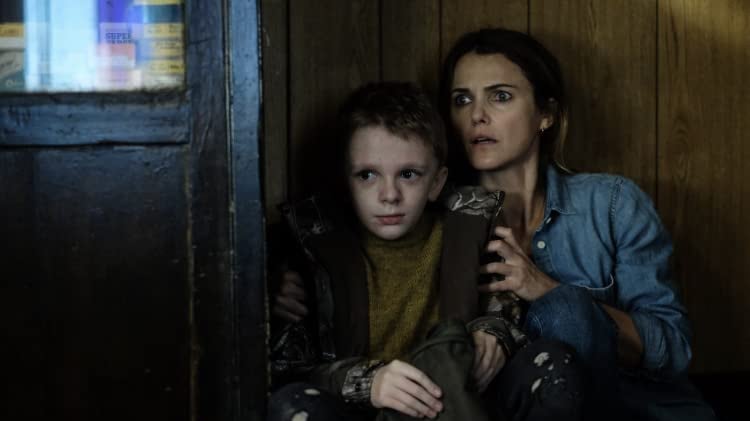As far as faux-Oregon movies go, Antlers tries tapping into relevancy. Set in the fictional town of Cispus Falls—but shot largely in Hope, British Columbia—director Scott Cooper’s horror debut tangles with rural poverty, addiction, environmental pillaging, and Indigenous erasure that literalize into a monster. In this case, the monster is a Wendigo—the cannibalistic, horned humanoid of many Algonquin-speaking tribes’ folklore.
In a town analogous to any number of isolated Northwest Oregon highway communities, Keri Russell (The Americans, Felicity) stars as Julia, an elementary schoolteacher in the midst of an uneasy homecoming. Grappling with her own troubled past in Cispus Falls, Julia fixates on a frail, introverted student, Lucas Weaver (Jeremy T. Thomas). The bloodthirsty family of beasts that appear in his class drawings imply that just maybe all is not well at home. With her brother the sheriff (Jesse Plemons) in tow, Julia gradually strives to scope out the Weavers’ dilapidated home where ne’er-do-well father Frank and Lucas’ little brother have receded from view.
Antlers is based on a short story by Channel Zero showrunner (and co-writer of this movie) Nick Antosca; it’s a gutting little parable about a well-intentioned young teacher playing savior in rotting Appalachia. While Cooper’s film maintains that mood, it’s mired in additional paint-by-numbers screenwriting. Julia’s abusive past is agonizingly broached and rebroached to inflect Lucas’ story, while Antlers’ haphazard explanations of the supernatural only cheapen the Wendigo myth.
Combine that with Cooper’s inexperience directing horror, and it’s a superficially polished, well-acted movie that gravely stammers through a repetitive 95 minutes. It’s as though there is a contest between how many times Julia can stare at Lucas’ drawings versus how many times characters can almost enter the Weaver house. Later, after one character investigates a suspicious shed, another character identically investigates the same shed. Cooper has big ideas for backgrounding the community violence—there’s a radio broadcast about rolled-back coal mining regulations and monologues about child protective services failing—but precious few ideas for making a dynamic horror movie.
This lack of imagination sadly sells short some gnarly production design and eyelid-peeling creature effects. (It feels like Guillermo del Toro produced this simply because there was a monster with antlers.) Why, for instance, if your movie hinges on a terrifying deer-man in the Pacific Northwest’s steroidal nature, would you stage every scary scene in dark rooms without space to sprint, charge or climb? It’s like setting the tale of a man-eating cheetah in a supply closet.
In Cooper’s oeuvre, Antlers isn’t unfamiliar, though. Dating back to his Crazy Heart debut, he’s coaxed deep commitment from great actors in shaky, self-serious movies about American conquest and collapse—Out of the Furnace, Black Mass, Hostiles. Here, it’s completely understandable why Keri Russell would embrace a part wherein she faces down evil, trauma and alcoholism (even if the movie is unsure whether she or Lucas is the main character). And Plemons remains one of the best working actors in a nothing part where he stressfully tugs on his cop ‘stache and is somehow fascinating the whole time.
To be fair, Antlers does possess one unexpected screenwriting flourish that pivots the movie away from The Hills Have Eyes or Slither-esque hillbilly exploitation. But that sensitivity and the care that went into consulting on Wendigo lore with Native artists and experts (including Portland State University professor Grace Dillon) amounts to very little. Antlers still haphazardly tokenizes Graham Greene (Dances With Wolves) into explaining the creature: essentially, “Hold on guys, let me grab my book of pan-Indigenous scary stuff.” Then, he promptly exits the movie, cementing a far worse iteration of the cultural tourism upon which the original short story seems to comment. (Honestly, check out last year’s Blood Quantum if you seek a recent, well-done First Nations horror movie.)
With a nod to all the film’s Douglas fir license plates, the most small-town Oregon facet of Antlers is a simple one-liner. Sheriff Paul (Plemons) sizes up Lucas’ demonic drawings and asks if that’s what passes for arts education at his sister’s old school in California. It stands out, too, as the movie’s sole moment of levity. Of all forms of nonsense, grim nonsense has to be the worst.
SEE IT: Antlers screens at Bridgeport, Cedar Hills, Cinema 99, City Center, Clackamas Town Center, Cornelius, Dine-In Progress Ridge, Eastport Plaza, Evergreen Parkway, Fox Tower, Lloyd Center, Movies on TV, Sherwood, Tigard, Vancouver Plaza.
